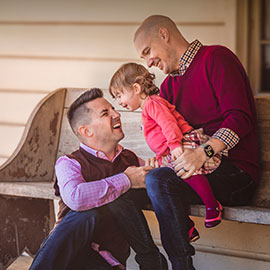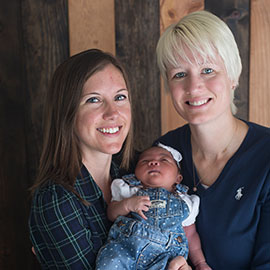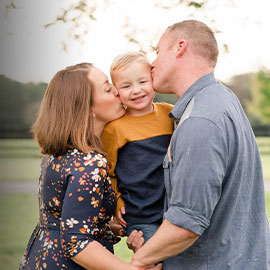

Transracial adoption (sometimes referred to as "interracial adoption" or "multiracial adoption") is the adoption of a child who is of a different race or ethnic background from the adoptive parents. In the United States, the Department of Health and Human Services estimates that 40% of all adoptions are transracial adoptions. This number has grown in past years, as adoptive parents and birthmothers alike are opting for transracial adoptions. Though there are unique challenges associated with this type of adoption, there are also many benefits for prospective parents and adopted children alike.
For parents and families considering transracial adoption, or for those who have already been chosen by an expectant mother of a different race, it’s essential to learn about and be prepared for the various aspects that make this type of adoption unique.
Start Your Adoption Journey TodayIt Starts With Love, Always
There are many different types of adoption, and more than ever, adopted families come in all shapes, sizes, and appearances. Regardless of what a family looks like, each one is built on the foundation of love, care, and compassion. This strong foundation helps adopted families build a future together, and, more importantly, it helps them grow in ways they may not have anticipated. For families of transracial adoptions, this love and commitment to one another can help them overcome the many challenges and obstacles they may face, as well as appreciate the unexpected benefits.
Transracial Adoption: How to Prepare for Challenges
Like every adoption journey, there are always unique challenges prospective parents may face. For transracial adoption, we’ve listed some of the more common issues:
-

As part of your adoption home study, you may be required to get explicit approval to adopt a child of a different race or cultural background.
-

As your adopted child grows up, they may experience identity issues.
-

Family, friends, and/or others may be critical of your transracial adoption.
-

Your family may experience racism, including slurs, hurtful comments, and discrimination.
In anticipation of these challenges, prospective adoptive parents can ask themselves the following questions:
-

Am I willing to educate myself about my child’s cultural and racial background?
-

Can I find appropriate community members and resources that can help my child learn about their background?
-

Am I willing to celebrate and advocate for my child’s heritage, including commemorating important, culturally significant milestones?
-

Can I face criticism, mean comments, and probing questions from strangers, family members, and friends?
-

In the face of discrimination, can I be a strong advocate for my child’s needs?
-

If I have a partner, is my partner committed and willing to share in the challenges and responsibilities of transracial adoption?
Your Child’s Culture
Heritage and identity are important for everyone, and for parents considering transracial or interracial adoption, learning about their child’s heritage is an essential step. Before children even begin asking questions about their heritage, prospective parents must learn about their child’s background. This includes the culture’s history and milestones, as well as being able to find important community resources that can help celebrate and nurture an adopted child’s understanding of their background. This is imperative because children will need to be functioning members of their native culture, and the way to accomplish this is for adoptive parents to ensure that the culture is always honored, upheld, and respected.
Enlist the Aid of Others
When your child begins asking questions about their heritage, ethnicity, or background, it’s best to be open and honest with them. Providing the insights you have learned is helpful, but sometimes, parents of different racial backgrounds may need to enlist the help of community members or resources reflective of that native culture. Finding these means of support can help nurture your child’s understanding, sense of self, and cultural identity.
For example, consider the importance of hair and skin care in the Black community. Hair, in particular, is a deeply held symbol of identity, freedom, and creativity. Despite their intentions, when a child’s parents or guardians do not provide the appropriate level of care required by their culture’s standards or their individual needs, others see it as neglect. This also applies to adoptive children in the Black community. Adoptive parents need to understand how this perception can affect their child’s psyche, self-esteem, and internal messaging. It is the adoptive parents’ responsibility to educate themselves on this fundamental topic and provide the appropriate resources necessary to meet these cultural standards.

"We are blessed to have two boys, both adopted, with two different stories. Our family story is incomplete without theirs, and without the trials and tribulations we went through to get here, we would not be a complete family."
- Brittany & Shana

Benefits of Transracial Adoption
Transracial adoption can be an enriching, broadening, and empowering experience for prospective parents. Learning about another culture or heritage not only increases one’s understanding, but it can promote deeper empathy and appreciation. Consider these benefits:
-

Deeper awareness: Adoptive parents of children of another race or heritage have the opportunity to more deeply explore a different culture. Through this immersion, prospective parents gain a greater insight and appreciation for a culture other than their own, as well as a better understanding of diversity as a whole.
-

A new family dynamic: Transracial adoption offers families the chance to create a shared experience that celebrates the cultures and heritages of both the parents and their adopted children. This can create a beautiful dynamic that’s unique to the family.
-

Healthier identity: It’s common for children of transracial adoptions to face differences and questions about identity at a younger age. When answered open and honestly, supported, and handled with love and respect, this can lead to a healthier sense of self earlier on in a child’s development.
-

Greater inclusivity: Because children of transracial adoption often have to learn about race and diversity at an earlier age, this helps them to be more inclusive, open-minded, and tolerant.
-

A united community: By their very nature, families from transracial adoptions get to share in the joy, love, and positivity of people from other cultures or backgrounds. This can help fight the stigma of transracial adoption, as well as encourage family members to more easily connect with those of diverse backgrounds.
Ready to Start Your Adoption Journey?
Transracial Adoption Frequently Asked Questions
Are transracial adoption and transcultural adoption the same?
No. While there is plenty of overlap between transracial and transcultural adoption, they are not exactly the same. Transcultural adoption refers to the adoption of a child from a different cultural background, which may not always mean a different racial background. Transracial adoption, on the other hand, refers to the adoption of a child from a different racial background, which often involves a diverse cultural background.
Do adopted children struggle with identity?
It’s common for children, whether from a transracial adoption or not, to struggle with identity when they learn about their background. When adoptive parents respond with unconditional love, support, and acceptance for their child, as well as open and honest answers, this can affirm a child’s sense of self. For transracial adoptions specifically, helping children learn about their heritage and racial backgrounds, as well as how to function in their native culture, can assist in overcoming identity issues.
How can we navigate the topic of race as adoptive parents?
The key to discussing race or any other topic is being open, honest, and compassionate. When adoptive parents are supportive of their child’s heritage and treat it with the utmost respect, this can help children embrace and have confidence in their self-identity.










